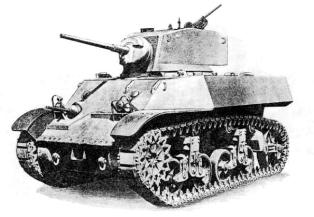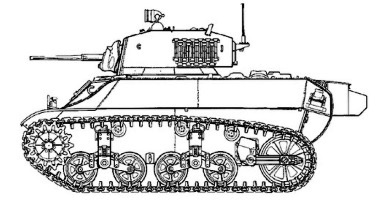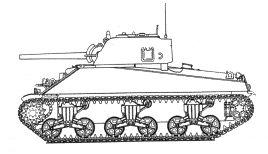
TANKS OF THE 1st PTG
M3A3 Light Tank
The M3A3 was produced almost exclusively for Lend-Lease and saw service with the British and Commonwealth Armies in Italy and NW Europe as well as with the Chinese. The M3A3 had a redesigned hull, all welded, one piece hull front. Production was halted in 1943 in favor of the new M5 Light Tank. The M3A3 was also known as the Stuart V.
M3A1 hull was redesigned with a sloping glacis with roof hatches for the driver and co-driver as well as increased internal space for the previously cramped driver and co-driver. Escape hatches, fire protection, and ventilation were improved. When in travel, the driver and co-driver could raise their seats so that they could look out of the hatches. Newly designed extendable steering levers were used in this raised position along with a removable windshield and canvas cover that was attached to mounting brackets on the glacis plate. A bustle was added to the turret rear for radio gear. Pistol ports were done away with.
By the time the M3A3 was produced between September 1942 and September 1943 with 3427 vehicles being produced of which 2045 were supplied to Britain and most of the remainder being sent to other Allies. Of those few vehicles retained by the U.S., none saw combat and were only used for training. By this date, the design was "tired" for western use, being under-armed and under-protected by the standards of warfare there.
Production was halted in 1943 in favor of the new M5 Light Tank.

| Crew | 4 |
| Weight | 27,000 lbs |
| Length | 14' 7" |
| Width | 8' 4" |
| Height | 8' 2 3/8" |
| Armament | 1 x 37mm, 4 x .30cal |
| Top Speed | 35 mph |
Initially known as the T6 Medium Tank, the M4 "General Sherman" would go on to become one of the most important and most produced tanks of WW2 and was only out produced by the Soviet T34. Seeing battle on all fronts and in a plethora of forms, the tank would become one of either fond or awful memory to the soldiers who handled it. Often misused and asked to handle tasks usually assigned to heavy tanks in other armies because there was nothing else available. The tank was nimble, reliable, and had superior gun controls - which is part of the reason it was kept around when it should have been replaced. The initial production model's armor and 75mm gun were excellent but fluid battlefield conditions would render it weak and finally obsolete barely a year after introduction in Europe. In the East, the M4 would remain peerless throughout the war.
The main armament of all M4s was a cannon in a coaxial mount with a .30cal Browning Machine Gun M1919A4. In addition, a (same model) MG was provided in a ball mount in the bow. All U.S. Army M4s were equipped with a .50cal Browning Machine Gun M2-HB in a pintle mount on the turret. Prototype and early production M4s had a pair of fixed .30cal Browning Machine Guns in a fixed mount in the bow which were deleted as combat showed that they were useless. Crewed by 5 men, about 44,000 were armed with the 75mm Gun M3, 6,465 with the 76mm Gun M1, and 4,180 armed with the 105mm Howitzer M4

| Crew | 5 |
| Weight | 69,700 lbs |
| Length | 19' 10.5" |
| Width | 8' 7" |
| Height | 9' |
| Armament | - |
| Top Speed | 25 mph | fs
Information from TANKS!